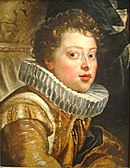
Mantua is a comune (municipality) in the Italian region of Lombardy, and capital of the province of the same name.

The House of Gonzaga is an Italian princely family that ruled Mantua in Lombardy, northern Italy from 1328 to 1708. They also ruled Monferrato in Piedmont and Nevers in France, as well as many other lesser fiefs throughout Europe. The family includes a saint, twelve cardinals and fourteen bishops. Two Gonzaga descendants became empresses of the Holy Roman Empire, and one became queen of Poland.

The Duchy of Parma and Piacenza was an Italian state created in 1545 and located in northern Italy, in the current region of Emilia-Romagna.

Vincenzo Ι Gonzaga was the ruler of the Duchy of Mantua and the Duchy of Montferrat from 1587 to 1612.

Margherita Barbara Gonzaga, was an Italian noblewoman, Duchess consort of Ferrara, Modena and Reggio between 1579 and 1597 by marriage to Alfonso II d'Este, Duke of Ferrara, Modena and Reggio. She was a significant cultural patron in Ferrara and Modena.

The Duchy of Ferrara was a state in what is now northern Italy. It consisted of about 1,100 km2 south of the lower Po River, stretching to the valley of the lower Reno River, including the city of Ferrara. The territory that was part of the Duchy was ruled by the House of Este from 1146 to 1597.

The Duchy of Montferrat was a state located in Northern Italy. It was created out of what was left of the medieval March of Montferrat after the last Palaeologus heir had died (1533) and the margraviate had been briefly controlled by the Emperor Charles V. After that brief interlude, it passed by marriage of the last heiress, Margaret of Montferrat, to the House of Gonzaga, already dukes of Mantua. In 1574 the fief was elevated from Marquisat to Duchy.

Anne d'Alençon, Lady of La Guerche, was a French noblewoman and a Marquise of Montferrat as the wife of William IX, Marquis of Montferrat. She acted as Regent of the Marquisate of Montferrat for her son, Boniface from 1518 to his death in 1530.

Ferdinando Carlo Gonzaga was the only child of Duke Charles II of Mantua and Montferrat, and the last ruler of the Duchy of Mantua of the House of Gonzaga.

Margherita Gonzaga was Duchess of Lorraine from 1606 until 1624 by marriage to Henry II, Duke of Lorraine. She was an agent of Pro-French and anti Protestant policy in Lorraine, and is most known for her support of her daughter Nicole's right to the Duchy of Lorraine. She also claimed her right to Monferrato during the Mantuan war of succession.

Isabella Clara of Austria was a Duchess consort of Mantua, Montferrat, Nevers, Mayenne and Rethel by marriage to Charles II, Duke of Mantua and Montferrat.

Margaret Palaeologa, was the ruling Marquise regnant of Montferrat in her own right between 1533 and 1536. She was also Duchess of Mantua by marriage to Federico II, Duke of Mantua. Margaret acted as the regent of the Duchy of Mantua twice during the minority of her sons: for her elder son Francesco III Gonzaga, Duke of Mantua in 1540-1549, and for her younger son Guglielmo Gonzaga, Duke of Mantua, between 1550 and 1556.

Barbara of Brandenburg was a Marchioness consort of Mantua, married in 1433 to Ludovico III Gonzaga, Marquis of Mantua. She was referred to as a virago because of her strong character and forceful nature, and served as Regent of Mantua several times during the absence of Ludivico III between 1445 and 1455. She is regarded as an important figure in the Italian Renaissance and was a student of Vittorino da Feltre.

The Marquisate or Margraviate of Mantua was a margraviate located in Lombardy, Northern Italy. Placed under the sovereignty of the House of Gonzaga since its erection in 1433, it was further raised to Duchy in 1530.

The House of Guidi di Bagno is an old Italian noble family which moved first into Romagna and then into Mantua from the 14th century.
The following is a timeline of the history of the city of Mantua in the Lombardy region of Italy.

The siege of Mirandolain 1321, also known as the siege of Duke Passerino, was a military conflict involving Francesco I Pico, first lord of Mirandola, against Rinaldo dei Bonacolsi, better known as Duke Passerino, lord of Mantua.




















